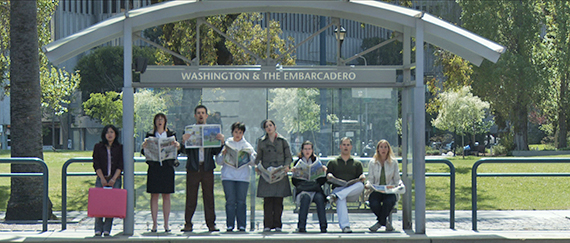
-biking, walking through San Francisco, and not even in Japantown or Castro, adds to the festival experience. It’s an angular city. It’s a film in the making.
When I went to boarding school in Pennsylvania, I used to visit my sister a lot at her college in West Philly, the Tenderloin of Philadelphia. Philly is a gritty place; the restaurant scene and the city’s long history are juxtaposed with the fanatic fan base of Philly sports and rough neighborhoods. San Francisco is no less a fighter, but she also has a sassy kick.
H.P. Mendoza’s FRUIT FLY expresses that musically, wonderfully. Watching it in the Castro Theatre, besides Harvey Milk Plaza, a few doors down from penis cookies, all in all captivating. Either Castro was filled with H.P.’s friends on Sunday night, or everyone became his friends by the time “Gay, gay, gay, gay!” was sung at the end. The audience reacted to a film, albeit a musical, as if they were at the latest U2 live concert.
I didn’t think the film had a large budget, but I couldn’t tell it had a very small one either (or that it was filmed in three weeks). One member of the crew mentioned that H.P.’s apartment was five different locations in FRUIT FLY. The film is filled with sparing, outrageous and searing wit. On a beautiful, sunlit San Franciscan afternoon, L.A. Renigen sits on a bench in the rolling greens of a park, a bit perplexed and about to contemplate. “Dirty Judy,” a largely absent housemate, suddenly sits down beside her and goes on a tirade about the “dick of a building” that blocks her view of the Golden Gate Bridge. San Francisco is not New York. In another scene, BART becomes Broadway. Time and time again, H.P. Mendoza takes shots of daily urban life and injects a kick of pure, sassy San Francisco into them.
The film’s storyline wasn’t overly ambitious either, capturing only a slice of Bethesda’s (L.A. Renigen) life and her quest for a complete identity. Along this juncture of her life are her housemates, Gaz Howard (a sly, self-celebrating magician/artist) and a Filipino aunt who makes overseas calls at ungodly early hours. By the end of the film *spoiler spoiler spoiler*,- Bethesda neither finds her mother nor is able to find a venue for the performance art piece that she performed in the Philippines. She doesn’t even find a beau to settle down with (Gaz fizzles out). While she doesn’t project her voice, she does lend a voice to Jacob, the frustrated 17 year-old who ran away from home and stays without rent, appearing in a slightly Gothic rock concert at an open mike with him.
Such brooding teenage angst is almost diametrically opposite to Bethesda’s performance piece. Not to say that her piece has no angst, but its emotional content is expressed with much more control and sophistication. Unable to resolve the heady identity crisis that weighs her down for most of the film, Bethesda goes along with one of the film’s songs, “workshop it baby, it’s my life, I’m trying something else.” A wisely simple approach to an identity crisis.
That brings me to Lee Ki-yoon’s MY DEAR ENEMY, a film that breathes simplicity in a very different way. For much of the film, simplicity carries itself with heaviness. You know that brief moment between breathing in and breathing out? It’s a short and tense interlude that we often forget. MY DEAR ENEMY spends most of its life living in that moment between inhaling and exhaling.
The film covers one day, one city, one car (mostly) and two people. It forces an uncomfortably specific zoom and packs in a couple casual contradictions. Cho Byung-woon is homeless and broke, and it doesn’t seem to affect him at all. Hee-su barely speaks and yet you wait somewhat scared but impatiently for a smile to break on her lips. The frugal dialogue is a string of rhetorical questions never quite answered. On foot, in a car, in a bus and in the subway, the couple navigates one of the world’s most bustling metropolises and in one way or another, make up along the way. As Lee Ki-Yoon explains in the Q&A session, he wanted to portray a more hostile physical environment that gradually warms as Hee-su’s emotionally softens; as Hee-su “humanizes,” the city does as well.
I’m not quite sure that the end brought me to an exhale. But that awkward feeling of the lingering middle brings healthy skepticism. It pauses life and awakens curiosity. Like FRUIT FLY, it takes a break from the continuous, heavy internal monologue that dominates our days and lays fresh, hopeful eyes on the present moment. What lies there, -what lies beyond our mind and within us?
L.V. Luong (in the admiring shadows of H.P. Mendoza and L.A. Renigen)




